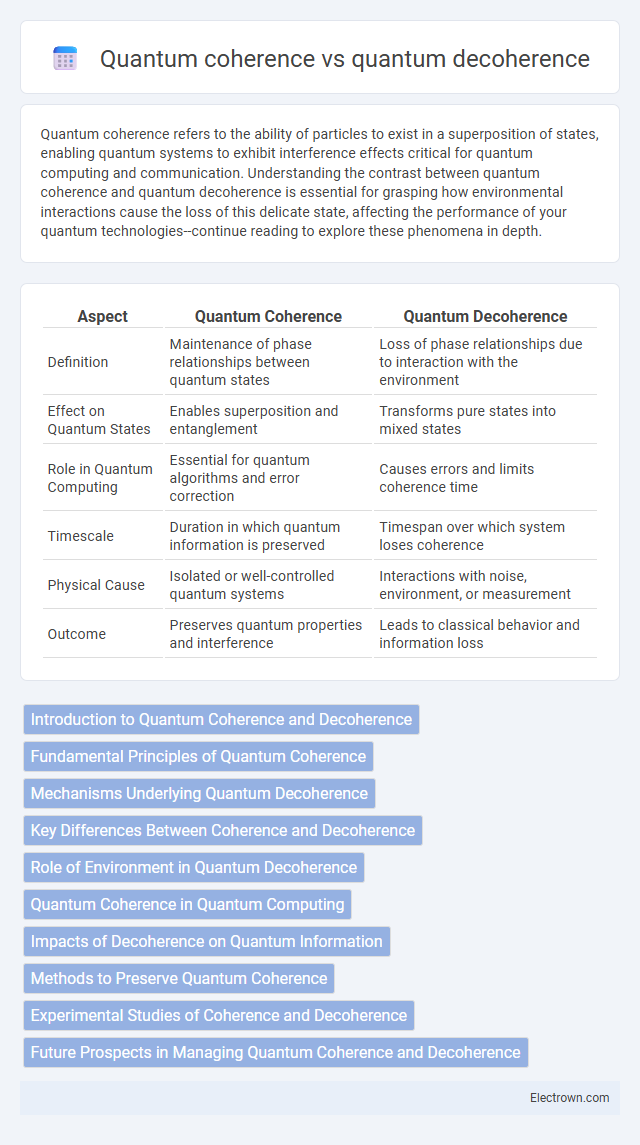Quantum coherence refers to the ability of particles to exist in a superposition of states, enabling quantum systems to exhibit interference effects critical for quantum computing and communication. Understanding the contrast between quantum coherence and quantum decoherence is essential for grasping how environmental interactions cause the loss of this delicate state, affecting the performance of your quantum technologies--continue reading to explore these phenomena in depth.
Table of Comparison
| Aspect | Quantum Coherence | Quantum Decoherence |
|---|---|---|
| Definition | Maintenance of phase relationships between quantum states | Loss of phase relationships due to interaction with the environment |
| Effect on Quantum States | Enables superposition and entanglement | Transforms pure states into mixed states |
| Role in Quantum Computing | Essential for quantum algorithms and error correction | Causes errors and limits coherence time |
| Timescale | Duration in which quantum information is preserved | Timespan over which system loses coherence |
| Physical Cause | Isolated or well-controlled quantum systems | Interactions with noise, environment, or measurement |
| Outcome | Preserves quantum properties and interference | Leads to classical behavior and information loss |
Introduction to Quantum Coherence and Decoherence
Quantum coherence refers to the property of quantum systems where particles exist in a superposition of states, enabling phenomena like entanglement and interference crucial for quantum computing and communication. Quantum decoherence describes the process by which a quantum system loses its coherent superposition due to interactions with the environment, leading to classical probabilistic behaviors. Understanding the mechanisms of quantum coherence and decoherence is essential for advancing quantum technologies and mitigating errors in quantum information processing.
Fundamental Principles of Quantum Coherence
Quantum coherence refers to the property of quantum systems where particles exhibit wave-like interference due to superposition states, enabling entanglement and precise quantum information processing. Quantum decoherence occurs when interaction with the environment causes loss of coherence, effectively collapsing superpositions and destroying entanglement, thereby transitioning quantum behavior into classical states. Understanding these fundamental principles is crucial for developing quantum computing and communication technologies that maintain coherence for practical use.
Mechanisms Underlying Quantum Decoherence
Quantum decoherence occurs when a quantum system interacts with its external environment, causing a loss of coherence between its superposed states. The environment effectively measures the system, entangling with its states and leading to the rapid decay of off-diagonal elements in the system's density matrix. This process transforms coherent quantum states into classical mixtures, disrupting quantum interference and limiting the practical implementation of quantum computing and quantum information processing.
Key Differences Between Coherence and Decoherence
Quantum coherence refers to the property of quantum systems where particles exist in a superposition of states, enabling entanglement and interference essential for quantum computing and communication. Quantum decoherence is the process by which coherence is lost due to interaction with the environment, causing a transition from quantum behavior to classical states. The key difference lies in coherence maintaining quantum information integrity, while decoherence leads to information loss and the collapse of quantum superpositions.
Role of Environment in Quantum Decoherence
Quantum decoherence occurs when a quantum system interacts with its external environment, causing the loss of coherent superposition states due to entanglement with external particles or fields. This interaction leads to the rapid decay of quantum coherence, making quantum information fragile and challenging to maintain in practical quantum computing applications. Understanding the role of the environment in quantum decoherence is crucial for developing error correction methods and designing isolated quantum systems to preserve coherence for longer durations.
Quantum Coherence in Quantum Computing
Quantum coherence is essential in quantum computing as it allows qubits to exist in superposition states, enabling parallel computation and increased processing power. Maintaining quantum coherence ensures qubits can perform complex algorithms reliably before quantum decoherence, the loss of this coherence due to environmental interactions, disrupts calculations and introduces errors. Your ability to optimize systems for prolonged coherence times directly impacts the efficiency and scalability of quantum processors.
Impacts of Decoherence on Quantum Information
Quantum decoherence disrupts the delicate quantum coherence necessary for maintaining superposition states, leading to the loss of information in quantum systems. This phenomenon significantly impacts quantum information processing by causing errors and reducing the fidelity of quantum computations and communications. Your ability to harness reliable quantum technologies depends on mitigating decoherence effects to preserve quantum coherence for longer durations.
Methods to Preserve Quantum Coherence
Techniques to preserve quantum coherence include dynamical decoupling, which applies precise sequences of control pulses to counteract environmental noise and reduce decoherence effects. Quantum error correction codes encode quantum information into entangled states, enabling detection and correction of errors that degrade coherence. Decoherence-free subspaces exploit symmetries in system-environment interactions, isolating quantum states from noise to maintain coherent superpositions over extended periods.
Experimental Studies of Coherence and Decoherence
Experimental studies of quantum coherence and decoherence have revealed crucial insights into maintaining quantum states in systems such as superconducting qubits, trapped ions, and quantum dots. Techniques like Ramsey interferometry and spin echo sequences quantify coherence times by mitigating environmental noise to observe decoherence mechanisms, including interaction with phonons and electromagnetic fluctuations. Advances in ultrafast spectroscopy and quantum error correction demonstrate experimental control over decoherence, enabling progress in quantum computing and information processing.
Future Prospects in Managing Quantum Coherence and Decoherence
Future prospects in managing quantum coherence and decoherence revolve around advanced error correction algorithms and materials engineering to stabilize qubits for longer durations. Quantum error correction codes, such as surface codes, are being refined to mitigate decoherence effects, enhancing the reliability of quantum processors. Your ability to harness these breakthroughs will pave the way for scalable, fault-tolerant quantum computing with practical real-world applications.
quantum coherence vs quantum decoherence Infographic

 electrown.com
electrown.com